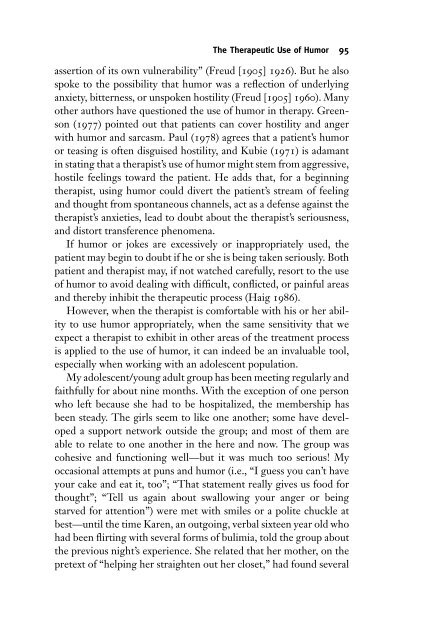Eating Disorders - fieldi
Eating Disorders - fieldi
Eating Disorders - fieldi
You also want an ePaper? Increase the reach of your titles
YUMPU automatically turns print PDFs into web optimized ePapers that Google loves.
The Therapeutic Use of Humor 95<br />
assertion of its own vulnerability” (Freud [1905] 1926). But he also<br />
spoke to the possibility that humor was a reflection of underlying<br />
anxiety, bitterness, or unspoken hostility (Freud [1905] 1960). Many<br />
other authors have questioned the use of humor in therapy. Greenson<br />
(1977) pointed out that patients can cover hostility and anger<br />
with humor and sarcasm. Paul (1978) agrees that a patient’s humor<br />
or teasing is often disguised hostility, and Kubie (1971) is adamant<br />
in stating that a therapist’s use of humor might stem from aggressive,<br />
hostile feelings toward the patient. He adds that, for a beginning<br />
therapist, using humor could divert the patient’s stream of feeling<br />
and thought from spontaneous channels, act as a defense against the<br />
therapist’s anxieties, lead to doubt about the therapist’s seriousness,<br />
and distort transference phenomena.<br />
If humor or jokes are excessively or inappropriately used, the<br />
patient may begin to doubt if he or she is being taken seriously. Both<br />
patient and therapist may, if not watched carefully, resort to the use<br />
of humor to avoid dealing with difficult, conflicted, or painful areas<br />
and thereby inhibit the therapeutic process (Haig 1986).<br />
However, when the therapist is comfortable with his or her ability<br />
to use humor appropriately, when the same sensitivity that we<br />
expect a therapist to exhibit in other areas of the treatment process<br />
is applied to the use of humor, it can indeed be an invaluable tool,<br />
especially when working with an adolescent population.<br />
My adolescent/young adult group has been meeting regularly and<br />
faithfully for about nine months. With the exception of one person<br />
who left because she had to be hospitalized, the membership has<br />
been steady. The girls seem to like one another; some have developed<br />
a support network outside the group; and most of them are<br />
able to relate to one another in the here and now. The group was<br />
cohesive and functioning well—but it was much too serious! My<br />
occasional attempts at puns and humor (i.e., “I guess you can’t have<br />
your cake and eat it, too”; “That statement really gives us food for<br />
thought”; “Tell us again about swallowing your anger or being<br />
starved for attention”) were met with smiles or a polite chuckle at<br />
best—until the time Karen, an outgoing, verbal sixteen year old who<br />
had been flirting with several forms of bulimia, told the group about<br />
the previous night’s experience. She related that her mother, on the<br />
pretext of “helping her straighten out her closet,” had found several









